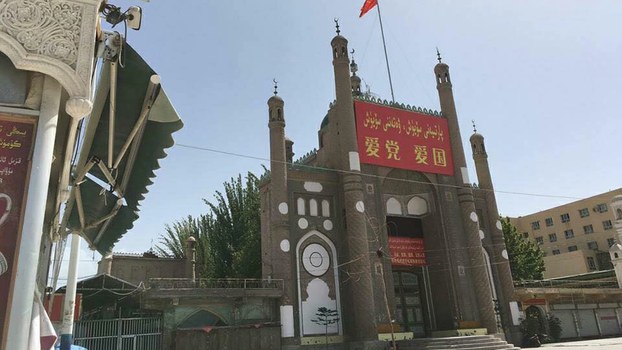A public toilet installed on the remains of the Tokul mosque in Xinjiang—and other rites of humiliation the CCP performs against religion.
by Matthew Omolesky

China’s campaign of religious repression and cultural destruction seems to operate in three distinct dramatic modes. There is the heart-rending tragedy one encounters in the demolition of Christian shrines, Islamic cemeteries, and folk religion temples. Then there is the sort of tragicomic bungling evident in the botched attempt to replace the First Guanyin of Shandong with a ludicrous representation of Confucius, or in the risible folly that was the so-called Chairman Mao Buddha Temple in Ruzhou City. And in recent months there have been numerous attempts at something approximating low comedy, boorish and lumpen, though precious few outside of local communist committees are likely to find any of it remotely amusing.
By “low comedy,” I am referring to a series of puerile attempts to humiliate Uyghurs and other Muslim minorities in the aftermath of the recent campaign of “mosque rectification,” a euphemism for the systematic bulldozing and desecration of thousands of Muslim places of worship, minarets, burial grounds, and mazars (tombs), including such powerful lieux de mémoire as the Imam Asim shrine situated north of the oasis city of Hotan. Where once the Tokul mosque stood in the village of Suntagh, in the vicinity of Atush, there is now a public toilet. Where the Azna mosque stood, there is now a convenience store provocatively stocked with alcohol and cigarettes. Where once a mosque stood in Lop County, an activities center is in its planning stages, while another mosque site in Ilchi township will soon feature a factory churning out underwear.
The installation of the public toilet facility on the remains of the Tokul mosque, an act profoundly offensive to anyone retaining even a modicum of civilized sensibilities, has not gone unnoticed in the international community, but when Radio Free Asia followed up on the story with the local committee chief, there was no acknowledgement whatsoever that the move was as an obnoxious misstep. Asked if there had been some pressing need for lavatory facilities amid the mosque ruins, the chief merely shrugged: “People have toilets at home, so there were not any problems like that.” The official position remains that the washroom was installed “for the needs of inspecting groups or cadres visiting the area,” an assertion that simply cannot be taken seriously. Indeed it can only be understood as part and parcel of an overall program of what the historian Qahar Barat has called “spirit breaking.”
Ismail Kadare, in his 1978 novel The Traitor’s Niche, outlined the various stages of cultural genocide, namely “first, the physical crushing of rebellion; second, the extirpation of any idea of rebellion; third, the destruction of culture, art, and tradition; fourth, the eradication or impoverishment of the language; and fifth, the extinction or enfeeblement of the national memory.” This “slow massacre, the protracted grief of centuries,” can be an attenuated process, but is a relative “cinch compared with the work of experts in ruthlessness, who, for research purposes, spent hours on end by cauldrons in which people boiled, or scaffolds where rebels were skinned.” In China, however, we see the two approaches coexisting alongside one another. Mosques are destroyed and replaced by toilets. The Uyghur “Mother Tongue” movement has been quashed, leading Abduweli Ayup to lament that “the words in their mouths are not very stable, just like a raindrop on a rose – when there is a gust of wind it will disappear.” But more proactive measures, like mass internment, slave labor, psychological pressures, torture, and forced sterilization, have been ramped up as well.
Darren Byler, in a haunting February 2020 article on the disappearance of the great Uyghur writer Perhat Tursun, recounted a conversation he had with another Uyghur literary figure, who graphically described how
One time my friends in prison after 2009 asked if they could watch Uyghur song and dance videos and the guard said yes. So 30 or so prisoners gathered in one cell and watched the videos. After a few hours, they were happy and were ready to return to their cells, but then the warden said, “No, you asked to watch films, so please keep watching.” So they watched the videos for 24 hours. Then they asked again if they could leave, because now they were becoming very uncomfortable, but the warden said, “No, you asked for this, please keep watching.” In the end, they watched the videos for 72 hours. The room was full of shit and piss and 30 men, finally they said they would never ask to watch films again and he let them go back to their cells. Fortunately, these men are very tough. They maintained their focus and didn’t let themselves become deranged. “
This is the sort of ritualized degradation that was on display in Nazi Konzentrationslager, with their systemic and institutionalized humiliation, or the Soviet gulag forced-labor camps, with their “kennel cages” into which naked prisoners were crammed for maximum ignominious effect. It must be remembered that, as the Nazi commandant of Treblinka, Franz Stangl, admitted in a 1971 interview, the wantonly humiliating and cruel acts perpetrated under those circumstances were not merely sadistic in nature; rather, they were committed in order “to condition those who actually had to carry out the policies. To make it possible for them to do what they did.” One senses a similar dynamic at play in Xinjiang and elsewhere. It is naturally a great deal easier to perpetrate cultural genocide, to torture, to harvest organs, or to sterilize young women, if the victim has been dehumanized first.
But it is not the victim, but rather the perpetrator, who is dehumanized in the process. The juxtaposition between a religious adherent who wishes to worship in peace and an apparatchik who bulldozes a mosque and erects a toilet could not be more clear. The juxtaposition between an imprisoned intellectual who asked to watch a song and dance video and the warden who then tortures him for days on end is likewise unambiguous. It is an extraordinary feat, amidst of all of this humiliation and cultural devastation, for the Uyghur people to continue to fight for their survival. One Uyghur song, composed by Musajan Rosi, tells of how:
We were few when we set out on our hard journey
At last we became a great caravan leaving our tracks in the desert
Tracks left in the desert, lives left by the tamarisk bushes
Heroes left in the dark desert without graves
Do not say those lives were left by the tamarisk without graves
New flowers will cover their graves in early spring
The caravan never stops though our horses are thin
If we achieve nothing our grandchildren will remain. “
There are a great many unmarked Uyghur graves scattered throughout the vast, unforgiving wastes of the Taklamakan, but the memories of those that came before have managed to endure. The subsequent destruction of Uyghur cemeteries has been a catastrophe, but not of a kind that can, on its own, destroy a people. Cultures are a great deal more than the sum of their parts.
It was the aforementioned poet Perhat Tursun, in his masterpiece “Qeside,” or “Elegy,” composed in Beijing in 2006, who perhaps put it best. While ruing how “they cut my head off just to test the sharpness of a sword,” he nonetheless assures his readers that “When they force me to accept the massacre as love / Do you know that I am with you,” and that “When they search the streets and cannot find my vanished figure / Do you know that I am with you.” As Tursun’s translator Joshua Freeman observed, the poem could serve as “an epitaph for all those lost to history’s great deadly ideologies,” but “the last line of each stanza, though, seems to offer individual human connection as redemption from the overwhelming impersonal tides of history.” Compare these immortal lines of poetry, and the cause for hope they offer, with the crass, even scatological rites of humiliation being imposed by the authorities in Xinjiang, and one quickly begins to get a sense of just who has managed to degrade whom.
Source: Bitter Winter



